Assessing the U.S. Climate in April 2025
NCEI News Feed
https://www.ncei.noaa.gov/news/national-climate-202504
The average temperature for the contiguous U.S. (CONUS) in April was 53.6°F, which is 2.6°F above the long-term average and ranks in the warmest third of the 131-year record.
NCEI News Feed
https://www.ncei.noaa.gov/news/national-climate-202504

Although wildfires are commonly associated with the West, the Great Lakes region has seen its share of destructive blazes. Lee Frelich, director of the University of Minnesota Center for Forest Ecology, warns that we will likely see more wildfires due to heat waves and droughts caused by climate change.
Vern Northrup is a former fireman and is a member of the Fond du Lac Band of Ojibwe.
Great Lakes Now
https://www.greatlakesnow.org/2025/05/wildfires-are-getting-worse-can-an-old-technique-help-control-them/
Federal funding cutbacks have impacted the staff at NOAA’s Great Lakes Environmental Research Laboratory. Severe spending limits have made it difficult to purchase ordinary equipment for processing toxic algal samples, and while remaining staff plan to launch large data-collecting buoys into the water this week, it’s late for a field season that typically runs from April to October. Read the full story by Planet Detroit.
Great Lakes Commission
https://www.glc.org/dailynews/20250507-algal-bloom-research-funding-cuts
For 8 hours overnight, there was a constant overflow and discharge of wastewater at Walter W. Bradley Wastewater Treatment Plant in Webster, New York, because of a power outage that shut down equipment and disabled the internet-based alarm system that would have alerted someone to the problem, according to New York State and Town of Webster officials. Read the full story by WROC-TV – Rochester, NY.
Great Lakes Commission
https://www.glc.org/dailynews/20250507-sewage-overflow
The Duluth City Council will be considering a resolution requesting federal officials to keep the U.S. EPA’s Great Lakes Toxicology and Ecology Division lab in Duluth, Minnesota, open. About 150 employees stand to lose their jobs at the lab that contributes $15 million to Minnesota’s economy each year. Read the full story by KBJR-TV – Superior, WI.
Great Lakes Commission
https://www.glc.org/dailynews/20250507-lab-resolution
The Executive Office of the President’s proposed 2026 federal budget includes a 25% reduction — nearly $1.5 billion — to the National Oceanic and Atmospheric Administration. That could gut funding for research programs monitoring water quality, weather conditions and fish populations across the region. Read the full story by Spectrum News 1.
Great Lakes Commission
https://www.glc.org/dailynews/20250507-research-funding-cuts
The sturgeon spawning run is continuing in parts of Northeast Wisconsin, including the Green Bay area, and the lower Fox River below the De Pere dam. Experts say the prehistoric sturgeon make it up the Fox River every year to begin spawning when the water temperature reaches 50-60 degrees Fahrenheit. Read the full story by WLUK-TV – Green Bay, WI.
Great Lakes Commission
https://www.glc.org/dailynews/20250507-sturgeon-spawning
As hundreds of thousands of alewife from Lake Ontario have been spawning for the season, authorities say recent weather changes have caused a surge in dead fish along the Greater Toronto Area shoreline. Read the full story by CityNews Toronto.
Great Lakes Commission
https://www.glc.org/dailynews/20250507-fish-die-off
The Great Lakes, and the fisheries sustained within them, support a multi-billion-dollar economy and countless jobs, all of which depend on the crucial scientific research conducted by many state and federal entities. The proposed elimination of funding for the U.S. Geological Survey’s Ecosystems Mission Area, under the guise of fiscal responsibility, is a dangerous misstep. Read the full story by The Post-Standard.
Great Lakes Commission
https://www.glc.org/dailynews/20250507-research-funding
According to a recent study by the Michigan Department of Natural Resources, smallmouth bass in Lake St. Clair are bigger than they used to be. Because the bass are often released back into the water instead of going home with fishers, they can live longer and grow bigger. Read the full story by Bridge Michigan.
Great Lakes Commission
https://www.glc.org/dailynews/20250507-bass-study
On May 7, 1965, the SS Cedarville sank beneath the waters of the Straits of Mackinac after a collision just one mile east of the Mackinac Bridge. The freighter plied the waters of the Great Lakes for almost 40 years before it crashed, ferrying loads of limestone from port to port. Read the full story by The Sault Ste. Marie Evening News.
Great Lakes Commission
https://www.glc.org/dailynews/20250507-freighter-sinking-anniversary
The educational team at Sleeping Bear Dunes National Lakeshore is unveiling a new program, “Sleeping Bear from Below.” The underwater documentary will be projected on the park’s 12-foot inflatable planetarium to bring an immersive experience for elementary students. Read the full story by MLive.
Great Lakes Commission
https://www.glc.org/dailynews/20250507-educational-program

Catch the latest energy news from around the Great Lakes region. Check back for these biweekly Energy News Roundups.
Just shy of six years since the passage of Ohio’s infamous House Bill 6, a more than $1 billion coal and nuclear bailout at the center of the largest bribery and money laundering scandal in state history, state lawmakers approved a bill that would repeal the coal subsidy House Bill 6 established.
Great Lakes Now
https://www.greatlakesnow.org/2025/05/after-six-years-ohio-moves-to-end-coal-bailouts-that-have-been-in-place-since-bribery-scandal/

By Anna Clark, ProPublica
This story was originally published by ProPublica.
Just one year ago, JD Vance was a leading advocate of the Great Lakes and the efforts to restore the largest system of freshwater on the face of the planet.
As a U.S.
Great Lakes Now
https://www.greatlakesnow.org/2025/05/millions-of-people-depend-on-the-great-lakes-water-supply-trump-decimated-the-lab-protecting-it/

A fledgling birding festival that hatched 15 years ago has become an international event drawing visitors from around the world to northwest Ohio. While the stars of the show at the Biggest Week in American Birding (BWIAB) are migrating warblers, there are dozens of other species which draw crowds from every state and continent including wading and shore birds, tanagers, songbirds, waterfowl and raptors.
Great Lakes Now
https://www.greatlakesnow.org/2025/05/everything-you-need-to-know-about-biggest-week-in-american-birding/

The Trump Administration’s proposed FY 2026 President’s Budget slashes federal non-defense spending and proposes steep cuts to federal programs that protect and restore the Great Lakes and the communities that depend on them.
The White House proposal to cut federal funding threatens Great Lakes residents, putting their health and economic security at risk by defunding water infrastructure programs, important research and observation programs, and efforts to assist communities overburdened from pollution. At the top of the list is the U.S. Environmental Protection Agency (“U.S. EPA”), with a proposed overall cut of 55% that would gut key water infrastructure programs that help pay for safe and clean drinking water, and stop sewage overflows, flooding, and basement backups. Also on the chopping block are the National Oceanic and Atmospheric Administration (-19%), the Interior Department (including the Fish and Wildlife Service, National Park Service, and U.S. Geologic Survey, -31%), and U.S. Department of Agriculture (-18%), all of which play key roles in restoring and protecting the Great Lakes through action on the ground and robust scientific research. Taken together, the White House proposal to gut federal funding not only threatens the Great Lakes but also sets up a showdown with Congress, which must decide whether to protect core funding for the programs it created or go along with the President’s proposed deep-cut budget.
Under this budget, U.S. EPA would abdicate a large portion of its federal responsibility and partnership with the states as set forth by Congress in both the Clean Water Act and Safe Drinking Water Act. And it comes at a time when water infrastructure needs are growing fast. Based on its 2023 Drinking Water Needs Information and Assessment Survey and its 2022 Clean Water Needs Survey, U.S. EPA estimates that Great Lakes states need at least $290.3 billion in water infrastructure investment over the next twenty years. Against this need, the proposed budget would decimate federal funding levels for the Drinking Water and Clean Water State Revolving Funds (“SRFs”) – the primary federal program for funding and financing water infrastructure projects – by nearly 90%. Such cuts threaten to destabilize states and communities struggling to ensure safe drinking water and protections from flooding and sewage. The Great Lakes states would see the following decreases in federal funding for water infrastructure programs:
| State | Decrease in federal water infrastructure funding |
|---|---|
| Illinois | – $94.6 million |
| Indiana | – $57.5 million |
| Michigan | – $84.1 million |
| Minnesota | – $41.2 million |
| New York | – $204.2 million |
| Ohio | – $102.9 million |
| Pennsylvania | – $89.2 million |
| Wisconsin | – $55.6 million |
While the states have built up funding in their state-administered SRFs since Congress established these programs, the states cannot meet the estimated water infrastructure needs on their own. The proposed budget ignores that federal funding plays key roles in state-administered SRFs. States rely heavily on federal funding to provide principal forgiveness or grant funding to disadvantaged communities that struggle to afford standard awards. States also use federal funding to help pay for staffing and technical assistance to communities, and to supplement repayable loan awards. U.S. EPA plays a key role in administering SRF funding, including assessing infrastructure needs on a regular basis to make sure funding goes to the states proportional to the need, and ensuring drinking water, stormwater, and sanitary system operators comply with standards that keep us and our waters safe. The White House’s blithe explanation that it is returning control of these programs to the states ignores the important federal partnership that has been underway since Congress first established these programs decades ago.
The administration’s budget also proposes a $1 billion reduction in EPA’s categorical grants. These programs support state efforts to implement Clean Water Act regulations, reduce lead in drinking water, reduce sources of non-point source pollution that fuels harmful algal blooms, assist small and disadvantaged communities struggling to implement water infrastructure programs, and develop a water workforce. Like the proposed reductions to the SRFs, the proposal to nearly eliminate all categorical grants upends important federalism goals for programs Congress established to deal with specific needs.
As noted above, the budget also includes steep cuts at the National Oceanic and Atmospheric Administration, the Interior Department (the Fish and Wildlife Service, the U.S. Geologic Survey and the National Park Service), and the U.S. Department of Agriculture. These cuts threaten the restoration of the Great Lakes by decreasing our ability to conduct scientific investigations, address runoff pollution and harmful algal blooms that threaten our drinking water, control invasive species to protect our fisheries, and protect national parks in the region.
The cuts in the administration’s proposal would threaten the quality of the drinking water relied on by more than 30 million Americans in the Great Lakes region. The cuts would defer and delay action to stop sewage backups into homes and surface waters, replace failing septic systems, and solve chronic flooding. Access to safe and clean drinking water and freedom from flooding and sewage impacts are basic needs that should be guaranteed to all citizens and communities across the Great Lakes.
The big question is whether Congress will agree to such steep reductions. The answer is unclear and, in some cases, such as the proposed $3.4 billion proposed cuts to water infrastructure programs, the answer may be a hard no.
Just last week, in a display of bipartisan unity, the Senate Environment and Public Works Committee, under the leadership of Senator Shelley Moore Capito (R-WV), held its first hearing on water infrastructure funding with the goal of finalizing a bipartisan water infrastructure package that would reauthorize both the Drinking Water and Clean Water State Revolving Funds, as well as other water infrastructure grant programs like the Water Infrastructure Financing and Innovation Act program. Sen. Capito, who played a leading role in negotiating the bipartisan Infrastructure Investment and Jobs Act of 2021 (IIJA) with its $50 billion investment in water infrastructure, extolled the federalism virtues of the SRFs and the important role they played in assisting states with meeting their water infrastructure needs and providing water services to underserved communities. Senator Capito, and the other senators attending the hearing including Senator Kevin Cramer (R-ND), Senator Adam Schiff (D-CA), Senator Lisa Blunt Rochester (D-DE) and Senator Angela Alsobooks (D-MD) all praised the IIJA water infrastructure funding, noting the many projects underway in each of their states addressing important community needs, including upgrading treatment facilities, replacing aging systems, supporting the needs of rural and underserved communities, replacing lead service lines, and dealing with contaminants such as PFAS.
The debate in the reauthorization of water infrastructure programs is not whether there will be the votes to pass the legislation, but how much control to give to states at the expense of federal oversight. These programs are designed to help states meet their obligations – and protect our health – under bedrock federal laws like the Clean Water Act. That is a very important question and one in which the answer has yet to emerge. The Senate Environment and Public Works Committee will be conducting other hearings on this topic and the House is expected to follow suit later this year.
In the meantime, the appropriations process is well underway, and the House and Senate Appropriations Committees have been working on the FY 2026 budget in anticipation of the start of the fiscal year this October. The Trump Administration’s FY 2026 budget proposal is just that, a proposal, and Congress will be evaluating the steep budget cuts. For our part at the Alliance, we will be meeting with members of the Great Lakes delegations to point out the many problems with the proposed cuts and working hard to ensure that the final budget package passed by the House and Senate protects and restores the Great Lakes.
The post Trump Budget Proposal Slashes Federal Funding, Threatens the Great Lakes and Sets Up Showdown With Congress appeared first on Alliance for the Great Lakes.
News - Alliance for the Great Lakes
News - Alliance for the Great Lakes
https://greatlakes.org/2025/05/trump-budget-proposal-slashes-federal-funding-threatens-the-great-lakes-and-sets-up-showdown-with-congress/
What can be done to address the growing problem of pollution caused by plastic in Great Lakes water? Watch our conversation with Great Lakes policy experts, researchers, and legislators about the latest efforts. Hear about new state legislation to reduce the worst plastics. Learn about new research and innovations, including recommendations for Great Lakes-wide monitoring of plastic pollution. Understand policy efforts to move the issue forward. This webinar was affiliated with Chicago Water Week, presented by Current.
The post Webinar: Reducing Plastic Pollution in the Great Lakes appeared first on Alliance for the Great Lakes.
News - Alliance for the Great Lakes
News - Alliance for the Great Lakes
https://greatlakes.org/2025/05/webinar-reducing-plastic-pollution-in-the-great-lakes/

Great Lakes Moment is a monthly column written by Great Lakes Now Contributor John Hartig. Publishing the author’s views and assertions does not represent endorsement by Great Lakes Now or Detroit PBS.
There is always room to improve program effectiveness and efficiency in government, as well as business, nongovernmental organizations and other institutions.
Great Lakes Now
https://www.greatlakesnow.org/2025/05/great-lakes-moment-government-downsizing-defunding-and-deregulating-at-what-environmental-cost/
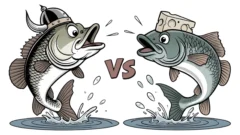
By Daniel Wanschura
Points North is a biweekly podcast about the land, water and inhabitants of the Great Lakes.
This episode was shared here with permission from Interlochen Public Radio.
Minnesota is known as the “Land of 10,000 Lakes”.
Great Lakes Now
https://www.greatlakesnow.org/2025/05/points-north-my-lakes-are-better-than-your-lakes/
Proposed federal budget cuts to the National Oceanic and Atmospheric Administration could pull the plug on a vital data network for Lake Michigan, impacting everything from boater safety and fishing forecasts to beach monitoring and drinking water intakes. Read the full story by Ottawa News Network.
Great Lakes Commission
https://www.glc.org/dailynews/20250505-trump-budget-cuts
Utility companies DTE Energy and Consumers Energy are entering the fourth year of a high-stake legal battle with the company they hired for the overhaul of the Ludington Pumped Storage Plant. Read the full story by MLive.
Great Lakes Commission
https://www.glc.org/dailynews/20250505-utility-court-battle
The U.S. Army Corps of Engineers has released a new, shorter timeline for its environmental review of the Line 5 tunnel project, reducing the public comment period to 30 days instead of 60. Read the full story by Interlochen Public Radio.
Great Lakes Commission
https://www.glc.org/dailynews/20250505-line5-schedule
Lake trout in some northern Ontario lakes aren’t as big as they used to be, and new findings have shown that when lake trout consume rainbow smelt it can lead to heart issues and thymine deficiency. Read the full story by CBC News.
Great Lakes Commission
https://www.glc.org/dailynews/20250505-ontario-smelt
The Pennsylvania Fish and Boat Commission held its quarterly meeting in April, during which the commissioners took action on several issues affecting anglers throughout the commonwealth, especially those in the northwest. Read the full story by Times Observer.
Great Lakes Commission
https://www.glc.org/dailynews/20250505-pfbc-meeting
The National Park Service has put another Lake Michigan shipwreck on the National Register of Historic Places, but most of the boat’s history remains unknown. Read the full story by Great Lakes Echo.
Great Lakes Commission
https://www.glc.org/dailynews/20250505-shipwreck
The first cruise ship of the season, Victory I, of Victory Cruise Lines, has visited the Soo Locks in Sault Ste. Marie, Michigan. Read the full story by MLive.
Great Lakes Commission
https://www.glc.org/dailynews/20250505-soo-cruise
To the delight of sailors across the country, a Michigan company has become the exclusive manufacturer of the Sunfish sailboat, launching the first U.S.-built Sunfish in years. Read the full story by the Macomb Daily.
Great Lakes Commission
https://www.glc.org/dailynews/20250505-sunfish-sailboats
CHICAGO, IL (May 2, 2025) – Efforts to keep the Great Lakes healthy and ensure the drinking water for 40 million people is safe to consume would be deeply harmed by the Trump Administration’s budget proposal announced today.
“We’re disappointed to see the President’s budget rejects core funding to restore safe drinking water, protect our communities from sewage and flooding, and implement federal clean water protections. We look forward to working with Congress to fund these vital Great Lakes programs,” said Joel Brammeier, President and CEO of the Alliance for the Great Lakes.”
###
Contact: Don Carr, Media Director, Alliance for the Great Lakes dcarr@greatlakes.org
The post Trump Budget Puts Great Lakes at Risk appeared first on Alliance for the Great Lakes.
News - Alliance for the Great Lakes
News - Alliance for the Great Lakes
https://greatlakes.org/2025/05/trump-budget-puts-great-lakes-at-risk/
A 16-year-old piping plover named Gabby returned to her home shoreline on Michigan’s Sleeping Bear Dunes National Lakeshore this month, just in time for breeding season. Read the full story by MLive.
Great Lakes Commission
https://www.glc.org/dailynews/20250502-oldest-piping-plover
Using fish waste as a fertilizer is a tradition that goes back centuries for some Native American tribes, including those who lived in the Great Lakes. Grand Traverse Band has gained international recognition in the wake of recent efforts to transform fish waste from local fishing operations into a high-quality fertilizer. Read the full story by Rural Innovation Exchange.
Great Lakes Commission
https://www.glc.org/dailynews/20250502-fish-recycling
Michigan officials say years of waves and extreme weather have led to significant erosion along the coastline. Parts of shorelines along Lakes Michigan, Superior and Huron have been designated as high-risk erosion areas, where a foot or more of terrain is lost every year. Read the full story by Fox News Network.
Great Lakes Commission
https://www.glc.org/dailynews/20250502-crumbling-shorelines
Sixth graders released more than a hundred chinook salmon into the Paw Paw River off the shoreline of Lake Michigan, learning lessons about conservation, ecosystems and wildlife management. Read the full story by WZZM-TV-Grand Rapids, MI.
Great Lakes Commission
https://www.glc.org/dailynews/20250502-salmon-release
A long-standing study in Lake Michigan and other Great Lakes has sought to determine the abundance of prey fish species, invasive species, and other forage species to determine the health of the lakes and their ability to support larger predator fish. Read the full story by the Ludington Daily News.
Great Lakes Commission
https://www.glc.org/dailynews/20250502-lake-health-study
In partnership with the Erie Bird Observatory, the lights on the Bicentennial Tower in downtown Erie, Pennsylvania, will be turned off to reduce lighting during a time of peak bird migration. Read the full story by TalkErie.com.
Great Lakes Commission
https://www.glc.org/dailynews/20250502-lights-out

By Zaria Johnson, Ideastream Public Media
This story was originally published by Ideastream.
An exhibition at the Cleveland Botanical Garden features more than 30 artists whose work explores the role nature plays in overcoming painful emotions and experiences.
The botanical garden partnered with local gallery Deep Roots Experience to bring together The Nature of Healing, an exhibition exploring ways the outdoors can help process grief and trauma.
Great Lakes Now
https://www.greatlakesnow.org/2025/05/nature-as-a-spiritual-salve-for-grief-cleveland-botanical-garden-looks-at-healing-power-of-outdoors/
Some of the woody debris from northern Michigan’s recent ice storms might go to places like landscaping businesses to use as mulch. But they’re also selling it to biomass facilities nearby, which will turn that into energy. Read the full story by Interlochen Public Radio.
Great Lakes Commission
https://www.glc.org/dailynews/20250502-ice-storm-energy
The Lake Sturgeon, a prehistoric fish, has long been deemed a protected species. Experts now hope that the ongoing restoration efforts will be successful. Read the full story by Oscoda Press.
Great Lakes Commission
https://www.glc.org/dailynews/20250502-sturgeon-restoration
State and federal officials said they are working with a chemical manufacturing plant in Wyandotte, Michigan, on a “two-pronged approach” to limit the flow of contaminated groundwater into the Detroit River. Read the full story by The Detroit News.
Great Lakes Commission
https://www.glc.org/dailynews/20250502-river-pollution
Michigan’s cruising season is underway. The 665-foot Viking Octantis got things started on Friday when it docked in Detroit. Read the full story by MLive.
Great Lakes Commission
https://www.glc.org/dailynews/20250502-cruise-ships
Research into centuries-old fire-scarred trees in northern Wisconsin is helping shape current fire management practices for tribal and state partners. The project, We are all gathering around the fire, or Nimaawanji’idimin giiwitaashkodeng in Anishinaabemowin, combines dendrochronology, Native Experiential Knowledge (NEK), and community engagement to uncover the intertwined ecological and cultural history of this Lake Superior coastal landscape.
The two-year Wisconsin Sea Grant-funded project, featured in a new video, confirmed something long known in Indigenous communities but rarely acknowledged in scientific literature: the beloved red pine forests on Wisconsin and Minnesota Points were not shaped by nature alone, but by people who used fire to care for the landscape. Red pine struggles to produce new generations without fire.
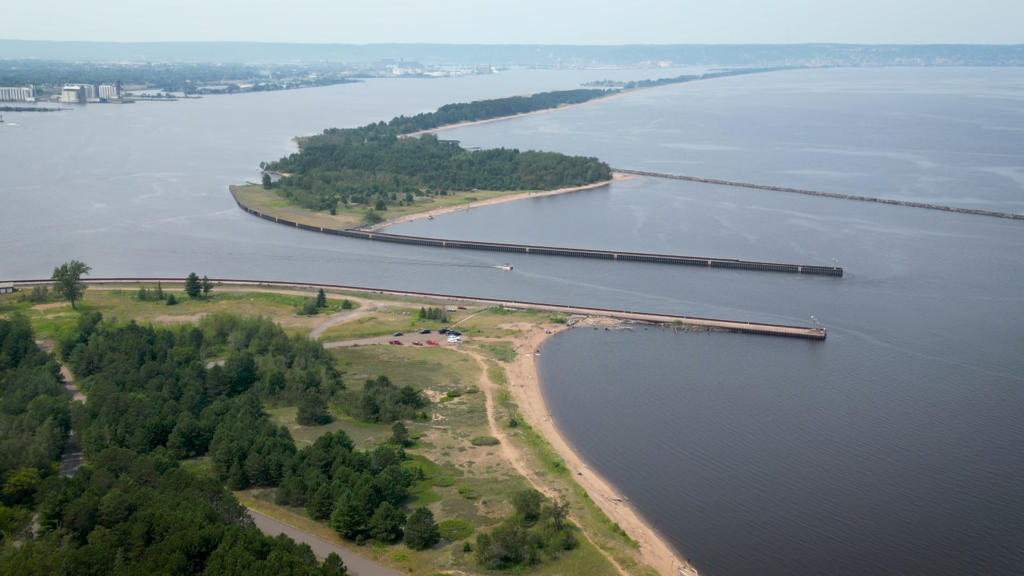
Wisconsin and Minnesota Points are Lake Superior coastal peninsulas off the shores of Duluth, Minnesota, and Superior, Wisconsin.
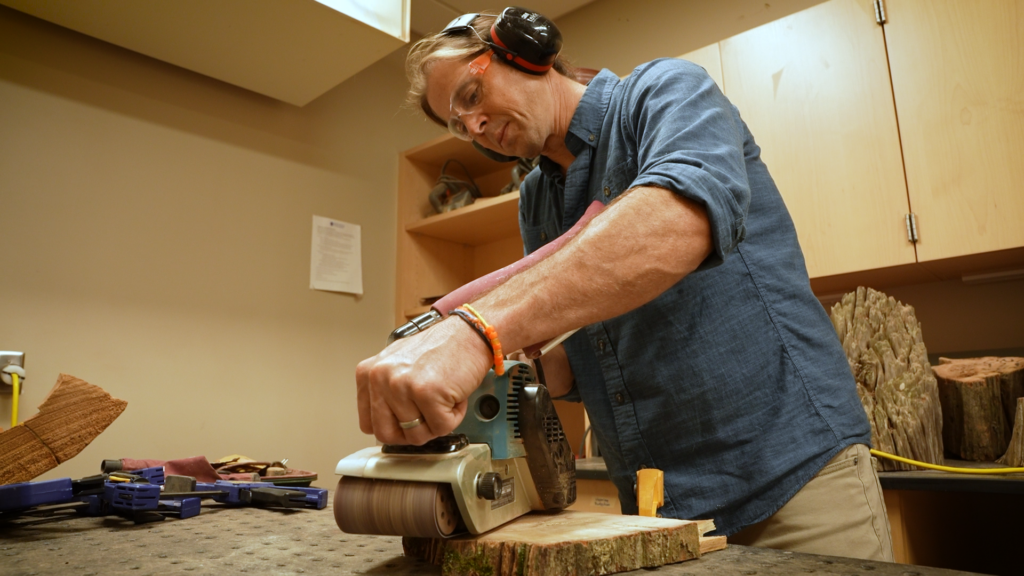
Dendrochronologist and Professor Evan Larson sands a wood sample to get it ready for the microscope.
The exclusion of Indigenous perspectives and burning practices in the forest management has led to reduced ecosystem resiliency, biodiversity, and a drop in the pine tree population. In order to prove that people, and not natural phenomena like lightning, set fires to the landscape, the team looked for centuries-old fire scars from tree samples collected on the Points. The data confirm what the team expected.
“The fires on both Points ceased abruptly after the signing of the 1842 and 1854 treaties,” said Evan Larson, professor at the University of Wisconsin-Platteville. “It is undeniable that the reason that we love the Points and protected the pine forest is because of the fires that people were setting,” Larson said. “That act of ‘protecting’ – moving people out of that space – is literally dooming the things that we’re hoping to protect.”
After two years of research, engagement, and outreach, the team has shown the importance of fire and NEK to Wisconsin and Minnesota Points. This has allowed them to take important steps to return cultural fire to the landscape.
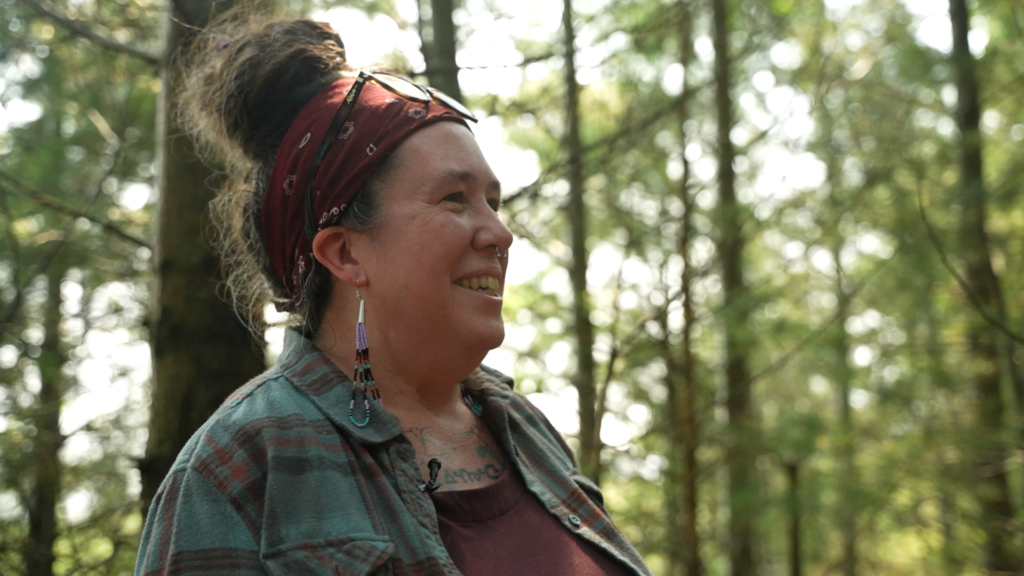
Melonee Montano, project leader and University of Minnesota-Twin Cities Forestry Department graduate student, talks about the deep significance that Wisconsin and Minnesota Points hold to the Anishinaabe people.
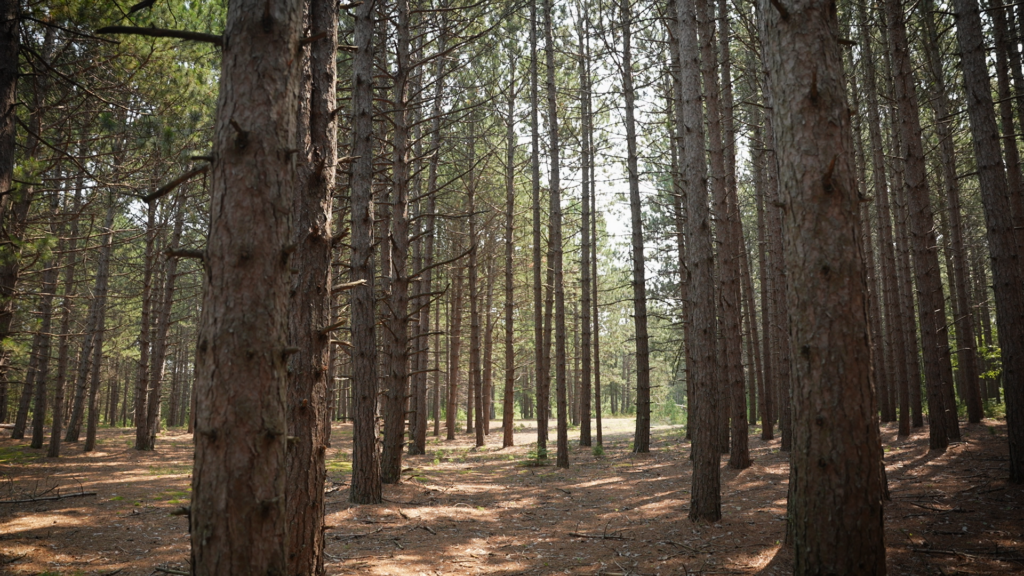
Fire helps red pines, like the ones pictured here on Wisconsin Point, regenerate.
“One thing that has made this research extremely successful is the funding from Wisconsin Sea Grant, because that’s been our starting point for all of this,” says project and tribal leader Melonee Montano. Throughout the project, Larson, Montano, and their students talked to local residents about the history of fire and the possibility of returning it. “The funding made it possible for us to go out and actually build these relationships on the ground, in people’s homes, at their kitchen tables, and at the city meetings.”
Larson and Montano have been surprised by the amount of support they’ve gotten from the community. “Through this work, we’re seeing, in ways that I can’t put into words, that it’s time for fire to come back,” says Montano. The city of Superior is now in advanced discussions with fire experts from the Fond du Lac Band of Lake Superior Chippewa about burning practices on Wisconsin Point.
“A lot of this really has only been possible because of this grant, which is really weird for my mind to process,” reflects Montano. “It’s strange to think that it took a grant – a piece of paper, some money – to bring these folks together to actually start tearing down through the layers of trauma to figure out what is at the base and what really happened.”
While the Sea Grant funding has come to a close, the team continues their work supported by a grant from the National Science Foundation. They will be broadening their research to encompass the whole Great Lakes region.
The post Watch: How tree rings and community conversations are bringing fire back first appeared on Wisconsin Sea Grant.News Releases | Wisconsin Sea Grant
News Releases | Wisconsin Sea Grant
https://www.seagrant.wisc.edu/news/watch-how-tree-rings-and-community-conversations-are-bringing-fire-back/
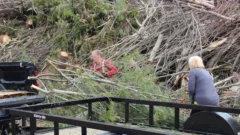
By Izzy Ross, Interlochen Public Radio
This coverage is made possible through a partnership between Interlochen Public Radio and Grist, a nonprofit environmental media organization.
At a giant dirt lot off a side road in Emmet County, the air smells sharply of pine.
Great Lakes Now
https://www.greatlakesnow.org/2025/05/northern-michigan-moves-to-clean-up-ice-storm-debris-by-making-energy/
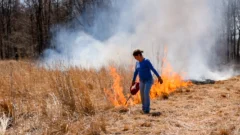
By Lester Graham, Michigan Public
The Great Lakes News Collaborative includes Bridge Michigan, Circle of Blue, Great Lakes Now at Detroit PBS, Michigan Public and The Narwhal who work together to bring audiences news and information about the impact of climate change, pollution, and aging infrastructure on the Great Lakes and drinking water.
Great Lakes Now
https://www.greatlakesnow.org/2025/04/prairies-on-fire/

By Leah Borts-Kuperman, The Narwhal
The Great Lakes News Collaborative includes Bridge Michigan, Circle of Blue, Great Lakes Now at Detroit PBS, Michigan Public and The Narwhal who work together to bring audiences news and information about the impact of climate change, pollution, and aging infrastructure on the Great Lakes and drinking water.
Great Lakes Now
https://www.greatlakesnow.org/2025/04/meet-the-people-trying-to-keep-a-prehistoric-fish-alive/
The Ohio House recently approved a state budget bill that would heavily cut H2Ohio, the clean water program that aims to scale back harmful algal blooms in Lake Erie. The measure would reduce Governor DeWine’s proposal of about $270 million over two years to about $150 million. Read the full story by the Review Times.
Great Lakes Commission
https://www.glc.org/dailynews/20250430-water-cuts
A federal judge in Detroit has ended litigation against one of the companies that consulted with the city of Flint when lead contamination led to a drinking water crisis 10 years ago. Read the full story by Michigan Advance.
Great Lakes Commission
https://www.glc.org/dailynews/20250430-flint-settlement
Regulators from the Michigan Department of Environment, Great Lakes and Energy are demanding that BASF, an international chemical manufacturing company, stop the flow of contaminated groundwater into the Detroit River, alleging the company is violating a 39-year-old consent agreement with the state. Read the full story by The Detroit News.
Great Lakes Commission
https://www.glc.org/dailynews/20250430-contamination-regulation
In New York state, the Onondaga County Water Authority has embarked on the biggest expansion of the regional water system since it was first built in the 1960s. Micron Technology’s planned semiconductor manufacturing complex in Clay, New York, and the growth expected to follow, could more than double the amount of water the authority draws from Lake Ontario. Read the full story by The Post-Standard.
Great Lakes Commission
https://www.glc.org/dailynews/20250430-water-supply-expansion
The U.S. Army Corps of Engineers, Detroit District, has established a safety zone extending 150 feet downstream of the Soo Locks Hydro Plant to ensure the safety of all mariners. The area immediately downstream of the power plant has many boils and whirlpools, making it unsafe for vessels. Read the full story by Soo Leader.
Great Lakes Commission
https://www.glc.org/dailynews/20250430-marine-safety
According to a recent study, recreational fishing trips in the Great Lakes generate $884 million per year. It found that almost 9 million people over age 18 were licensed to fish in one of the Great Lakes at the time of the study’s data request during the 2020 season. Read the full story by the Capital News Service.
Great Lakes Commission
https://www.glc.org/dailynews/20250430-angling-research
U.S. Senator Todd Young (R-IN) on April 30 reintroduced bipartisan legislation, known as the SHIPS Act, that intends to revitalize shipbuilding in the U.S. and close the ship vessel gap between America and foreign adversaries, such as China. Read the full story by The Indianapolis Star.
Great Lakes Commission
https://www.glc.org/dailynews/20250430-shipbuilding-bill